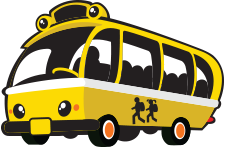School Bus Safety Rules
- Respect the driver and follow all directions.
- No talking or noise at railroad crossings.
- Promptly sit and apply your safety belt if so equipped. Stay in your seat, facing forward.
- Backpacks on the floor or in your lap. Nothing can remain in the aisle.
- No screaming, yelling, name calling, or bad language. Talk in a reasonable, conversational tone.
- No fighting, pushing, shoving – keep your hands to yourself. No throwing items on the bus.
- Windows to be open only halfway. No body parts should be outside the window. Objects should not be thrown from the bus.
- No eating or drinking on the bus. No vaping/smoking of any kind.
- Keep the bus clean and free from damage. Parents will be responsible for any repair costs for any damage caused. Throw garbage in the trash can, not the floor of the bus.
Buses & Drivers
The Bus
- There is no mistaking a school bus for anything other than a school bus. That distinctive yellow and black coloring, the stop arm, the flashing lights, are all designed to warn traffic that this special vehicle must be treated with extra respect and caution.
- Besides being highly noticeable, a school bus is exceptionally well built. Construction and equipment standards for school buses are controlled by more government regulations than any other vehicle on public roadways.
- There are specifications for the roof, tires, lights, mirrors, seats, safety equipment…even the number of bandages in the first-aid kit!
- In addition to regular maintenance by specially trained mechanics, the State Police inspect every school bus on a yearly basis.
The Driver
- Not just anybody can get behind the wheel of a school bus. It takes someone quite extraordinary to control a vehicle, watch traffic and road conditions, and at the same time attempt to manage as many as 72 high spirited youngsters.
- The legal requirements for becoming a school bus driver are very demanding. Drivers must be at least 21 years of age, be able to pass a DOT physical, participate in random drug and alcohol tests, possess a Commercial Drivers License, possess a State School Bus permit, have knowledge of bus equipment and maintenance and passenger safety and control as well.
- 40 hours of specialized training are followed by written exams and road test. Driving and criminal records are reviewed and regular medical and vision exams are required.
- Every driver at Lake Central must complete certified driver improvement courses, as well as know traffic laws and safety procedures inside out. Periodic re-examinations keep the school bus driver sharp and safety-wise.
The Teamwork
- Behind the drivers and buses is a complex network of service and support people. Mechanics, dispatchers, office staff, administrators, the school board and law enforcement. Each one plays a vital role in keeping Lake Centrals buses running safely and efficiently.
- Working together, these professionals decide which students are to be bused to school and where and when to pick them up. They set standards for behavior on the bus and handle discipline problems. They also research and enforce laws and regulations that govern school busing.
- Finding better and safer ways to protect students is a constant challenge, one that is approached with pleasure and pride.
